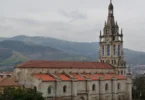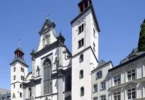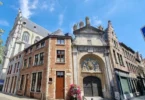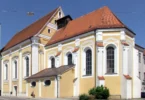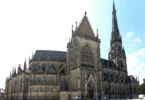
Introduction
The Church of Our Lady of Foy (Sanctuary of Our Lady of Foy, Dinant), located in the center of the village of Foy-Notre-Dame, six kilometres east of the town of Dinant in Belgium, is a Marian sanctuary dating from the 17th century. Built in 1623, the church is in the Mosan Baroque style. It has a remarkable ceiling of 145 coffers with paintings on oak wood of the Marian mysteries, saints and doctors of the Church. The church, recognized by the Royal Commission for Monuments and Sites since 1898, is listed as classified real estate heritage of the Walloon Region.
The building, made from local materials (Meuse limestone, Rance marble, brick, oak), is a perfect example of the know-how of the Belgian craftsmen of the time.
Sanctuary of Our Lady of Foy (Sanctuaire Notre-Dame de Foy) Located in a beautiful unspoilt environment on the heights close to Dinant, encircled by a few stone houses, this church owes its founding to the discovery of a statuette of the Virgin Mary in a hollow tree by a woodcutter in 1609. The statue was worshipped. As a result of miracles the place became a pilgrimage site and this church was built in 1623.
At this time the development of the cult of the Virgin was part of the Counter Reformation on the initiative of the Jesuits, who encouraged the cult of saints by images in reaction to the austere religion of the Protestants, who communed with God without intermediaries.
The most noteworthy feature of the building is its famous ceiling made of 145 panels of oil paintings depicting scenes from the life of Mary and portraits of saints. This ceiling is the work of the brothers Stilmant of Dinant and the painter Guillaume Goblet. It was restored in 1935 but now needs another refurbishment. Inside, apart from the celebrated ceiling, is the miraculous statuette on the left of the altar and various paintings including ones of the Virgin and Saint Joseph.
The immediate surroundings of the church are charming with a little graveyard next to it, a small wall encircling the church, a bench for visitors, an inn, a chestnut tree, a fine view.
History of Sanctuary of Our Lady of Foy, Dinant

Sanctuary of Our Lady of Foy, Dinant – When Abbots Félix Fries – parish priest of Foy-Notre-Dame from 1892 to 1906 – and Charles Petitjean took an interest in it, the church was in a pitiful state and threatened with ruin. Fries’ historical research helps draw the attention of civil authorities to the great historical and artistic value of the church. It was listed in 1898, and its restoration began immediately.
The work of the first major renovation spanned from 1898 to 1910 and was directed by the architect Auguste Van Assche. Although the Commission is absolutely keen to preserve the authenticity of the building, it will make profound changes both inside and outside. It endows the facade with a Louis XIII style portal. It extends downwards the two windows of the main facade as well as the first two bays on both sides of the building. Some stone parts are renovated. It endows the roof with five skylights. It was also at this time that the oak coffers of the ceiling were renewed and replaced by natural-coloured oak coffers which contrasted sharply with the “splendor of the paintings”.
On the old caissons replaced at this time (1908-1909), the Commission keeps precise information on their appearance and their main characteristics which will be used during subsequent work (1937). On these, there are traces of old carved patterns, nails which were to fix them, vermilion around the painting and a gilt frame at the base. The second major project is undertaken to repair the war damage (bullet impacts on the walls and at the level of the roof and damage due to a shell on the south-east facade).
The pilgrimages resume, with the support of the Bishop of Namur. As a new beginning, Bishop Heylen organized the coronation of Our Lady of Foy there on September 8, 1909: 10,000 pilgrims are present. On the occasion of the 25 years of reign of King Albert I, a great celebration took place in 1934 in his presence. 30,000 people, including Cardinal Van Roey, attend parades and religious ceremonies. Twenty-two statuettes from parishes around the world also dedicated to Notre-Dame de Foy are exhibited there.
Architecture of Sanctuary of Our Lady of Foy, Dinant

In 1618 the influx of pilgrims – and the publicity given to the place by the visit of the Archdukes Albert and Isabella in 1619 – leads to the construction of a larger chapel. Work began in 1622. The plans were drawn up by the brothers, Michel and Jaspard Stilmant with the help of Guillaume Goblet 2. However in the 19th century, historians attribute this work to B. Flémalle and an unknown Bartholomé 3.
The church is consecrated on September 8, 16244 by the Most Reverend Suffragan of Liège who, on this day of commemoration of the birth of the Virgin , replaces the Prince Bishop of Liège, Ferdinand of Bavaria. At that time, only the shell was completed. The coffered ceiling, meanwhile, was completed ten years later thanks to donations from pilgrims. The church receives, among other donations, an altarpiece offered by the Archdukes.
The prince-bishop of Liège appoints an administrator for what has become a Marian sanctuary: it is the Premonstratensian canon Jean Noizet, of the abbey of Notre-Dame de Leffe. Premises were built to receive pilgrims and Foy was erected as a parish (along with the neighboring village of Boisseilles). A small town is growing, but will never be bigger than it is today.
Throughout the 17th century, the sanctuary had an extraordinary reputation. Pilgrims come from everywhere. The veneration of Notre-Dame de Foy spread outside the country, propagated in particular by the missionaries who went overseas. A treasure accumulates in Foy, made of liturgical objects in precious metal offered by pilgrims. This does not fail to arouse envy.
The wars of the century did not spare the sanctuary: on several occasions, the church was vandalized and the statuette had to be hidden in Dinant. In 1696, the church was sacked by the Dutch Confederates. Religious articles are stolen or sold. The sanctuary does not rise easily. In the 18th century, mentalities having also changed, pilgrimages were less numerous. The decline initiated by the sacking of 1696 was accentuated throughout the 18th century.
Discovery of the Statue of the Virgin
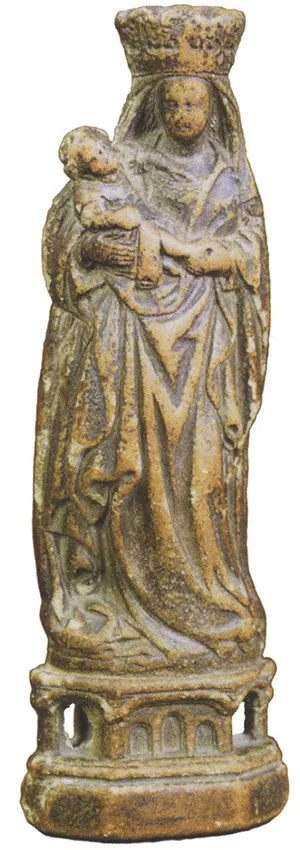
In 1609 Gilles, a woodcutter from Wanlin, and Innocent Delimoir who accompanied him, while cutting down an enormous oak tree which they had just cut down, discovered a small statue of the Virgin Mary there. Made of terracotta, it is surrounded by some stones and hair. Gilles and Innocent cry out for a miracle. The story spreads around, and very quickly a spontaneous cult develops.
In fact the oak was at the edge of a path taken by the pilgrims going to Saint-Hubert. Some two centuries before the discovery of 1609, one of them deposited in the hollow of the tree a statuette of the Virgin Mary. Over the years the bark of the tree closed over her and, the path being less and less frequented, the existence of the statuette was forgotten.
The statue was first replaced in another oak tree, but the Baron de Celles, having found that an attempt had been made to steal it, carried it to his oratory in the Château de Vêves (barony of Celles). Visitors and pilgrims begin to flock.
A first miracle took place in 1616 following the intercession of the Virgin Mary, an old man was cured of a hernia as painful as it was debilitating. The canonical inquiry prescribed by the bishop of Liège, Ferdinand of Bavaria, is positive in its conclusions.
Our Lady of Foy (Our Lady of Faith)
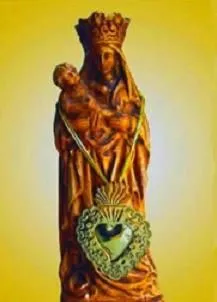
Our Lady of Foy also known as Our Lady of Faith (“Notre Dame de Foy”), not far from the small town of Dinant, in the country of Liege, near a home, two magnificent oak trees once grew. One of the two venerable old trees was felled in the year 1609 for the wood. The worker who inspected the tree found inside it a small statue of the Mother of God enthroned as it were, with three iron bars serving as a lattice. Apparently, some pious Christian soul had placed the holy image in a hole in the oak wood, as if it were a niche. Then, with the passage of time, the tree hid the precious figure in its bosom.
In honor of the Virgin, the statue was later displayed in the other oak, once again behind an iron fence, by order of the Baron of Celles. In this new Sanctuary the Mother of God was honored with the title of Our Lady of Faith. Those who passed by did not stop venerating the statue and there were many unexpected healings. Graces of all kinds multiplied, and soon pilgrims began flocking to the area due to dazzling miracles.
A priest from the Society of Jesus had recently been sent to Gravelines. He worked diligently to cultivate souls, as if on a fruitful vine, and by his sermons excited the peoples of the region to a greater love for the Mother of God. Seeing that this devotion had taken root in the people, he met with the local magistrate to discuss how to maintain and increase the piety of the people. It was decided that they should make replicas of the statue of Our Lady of Faith, made from the wood of the first oak. When the first was completed, it was noted that the image bore a strong resemblance to the original. The image was received with great joy, it was placed in a large reliquary on the main altar of the parish church.
The image of Mary, Our Lady of Faith (“Notre Dame de Foy”), was solemnly enthroned by the Bishop of St. Omer on the Feast of the Ascension. From the year 1622, she was honored by large assemblies of the faithful. A great number of miracles happened and continue to happen every day.
To satisfy the pious zeal of the faithful, the venerated image of Our Lady of Faith was reproduced and spread among the people. The oak, which for so many years had contained the image, served this purpose, as its wood was used to create other similar statues of Our Lady of Faith. They were distributed to churches in Bailleul, Dilingue, Gravelines, Huy, Lille, Lobbes, Marchiennes Montmartre, Saint-Omer, Oudenbourg, Reims, Ruislip, a D’Furnes, among others. These cities had the honor of possessing this image of Mary and welcomed the statue, made from the very wood of the Tree of Faith. In all these various localities Our Lady of Faith began to work wonders.
Of all the model wooden images of the original Madonna, perhaps the most famous is the one preserved today in Amiens Cathedral. The statue was placed in the church of the Augustinian religious at the beginning of the year 1629, whose monastery was located in the parish of San Miguel. From May 3 of that year the miracles happened and soon, by order of the bishop of Amiens Francois Le Febvre de Caumartin, they formed a commission to study and carry out scientific investigations of these extraordinary events. He concluded by canonically recognizing the devotion to the image and published four great miracles that had occurred, in addition to the most striking being the resurrection of a dead child.
Here are some details that recall this memorable prodigy. A child had fallen into a well and was buried for several hours. The devout Christians who fought to rescue him did their best to revive him but to no avail. Finally, the people took the child in front of the statue of Our Lady of Faith and knelt in prayer with confidence asking for Our Lady’s intercession. Immediately, the boy showed signs of life and woke up as if from a dream.
At Gravelines, there had been a child who had died at birth. As he was being prepared for burial, his grieving mother invoked Mary in the image of Our Lady of Faith. Suddenly, an exhilarating warmth spread through the boy’s frozen body, who then began to cry and wave his hands little. The child received baptism and was able to live his life with his mother.
During the plague of the year 1634 that devastated Amiens, the people of the city carried out a procession through the streets of the city with the image of Our Lady of Faith; the bishop presided over the ceremony and the Pontifical Mass is celebrated. Soon, the plague ceased.
In the year 1636 the noble ladies were frequently seen with their ladies-in-waiting praying before the holy image, and Cardinal Richelieu attending the litanies that were sung daily in this blessed sanctuary. Furthermore, the brotherhood, established under the title of Our Lady of Foy, included a number of high-ranking personages, such as King Louis XIII, Anne of Autricle, King Louis XIV, QueenMaria Theresa, King Louis XV, as well as themembers of the most noble and illustrious families of Picardy.
The religious association had chosen as its main feast the Visitation of the Blessed Virgin, a mystery that recalls so perfectly the incomparable faith of the Blessed Virgin Mary. All these wonders had an immense effect, and the number of extraordinary favors soon became considerable. The miraculous Madonna of Foy attracted the faithful more than ever in all their needs. The image of Our Lady of Foy was hidden to protect it from the wicked during the time of the French Revolution.
Later, the image was returned to the church, but the little Virgin was lost in the immensity of the cathedral and received the homage of only a few souls who knew and remembered. In 1878 Bishop Battle, of pious memory, celebrated Mass at Notre-Dame de Foy, and it was finally decided to restore this cult. Soon the venerable Chapter, supported by the Bishop, asked the Pope to deign to open the treasury of indulgences.
Many devotions and pilgrimages were once again performed in her honor, and candles were constantly kept burning before her image. Every August 15, the Feast of the Assumption, the public recitation of litanies was again resumed along with processions as people showed their love and appreciation for their Heavenly Mother. Since then, Our Lady of Faith constantly gathers new testimonies of love with her precious favors.
History of Our Lady of Foy

By 1618 the influx of pilgrims and the publicity given to the place by the visit of the Archduke Albert and Isabelle in 1619 led to the construction of a larger chapel which became a Marian Shrine. The work began in 1622 and the church was consecrated in 1624, although only the structural work was completed. The ceiling wasn’t finished for another dozen years, thanks to donations from pilgrims.
A booklet printed in 1623 spoke of the remarkable healings in the invocation of our Lady of Faith in Gravelines. In one case a man named Peronne Joncheers was very sick with swelling for which doctors did not know the cause or the cure. Hearing about the miracles made by our Lady of Faith, he went to Gravelines, confessed, and heard the Holy sacrifice at the altar of Mary. Barely had he received Holy Communion than his pain disappeared entirely.
He never suffered from the swelling again. In another case, Isabeau Carlier, had been burned due to clumsiness, becoming blind in the right eye from a hot iron. A surgeon said that the evil was without remedy. Isabeau recommended herself to Our Lady of Faith. She promised, if she were healed, to visit the chapel of Gravelines. The next day the surgeon checked her eyes again, throwing his scope as he was forced to acknowledge in his astonishment that the eye so damaged the day before had been miraculously healed, actually becoming clearer than the other.
There are three more cases I would like to relate. In the first, a man suffered horribly for three weeks. For three days his pain was such that he was in delirium, and physicians held not even a glimmer of hope for him. The friends who surrounded the patient’s bed, during a lucid moment, told the man about the graces obtained through the intercession of our Lady of Faith, whose image was venerated at Gravelines.
The patient couldn’t talk, but he responded with a sign that made it clear he was willing to make a pilgrimage there. At the very same time he began to feel much better, but not only did the Blessed Virgin give him back his health, but for three days she appeared to him at different times, surrounded by a dazzling light, and flooded him with heavenly consolations.
Another prodigy was narrated by the father of Balinghem, which was the resurrection of a stillborn child. While the midwife had already prepared everything for burial, the grieving mother invoked Mary in the image of our Lady of Faith, Gravelines, and her prayer was answered. A life-giving warmth could be felt spreading into the child’s icy limbs, who then began to cry and shake his small hands. The child received baptism, and now grows under the watchful eyes of his mother, for whom he is a constant consolation.
Finally, in reading what’s left of the Gravelines Church archives, there is mention of another prodigy operated during Lent in 1629. A ship captain had wrecked; the ship sank; sailors and passengers, everyone died; the captain alone was still battling the waves without hope of escape from death, because he was at least three leagues from Gravelines.
In this urgent danger, he called our Lady of Faith; he vowed to visit the chapel, if she desired to come to his aid. Then, in an instant, unable to explain how it had been done, the captain was suddenly standing safely on the shore. He hastened to accomplish his vow, and he told with gratitude to all those he met of the singular protection he had been granted.
During all of the 17th century the sanctuary had an extraordinary reputation. Pilgrims visited from all over. The veneration of Notre-Dame de Foy spread outside the country, taken overseas by the missionaries. A great treasure accumulated in Foy, of liturgical precious metal items donated by pilgrims. These offerings to God did not fail to arouse the lust of the godless.
The wars of the century also did not spare the sanctuary. On several occasions, the church was vandalized and the statue was hidden in Dinant. In 1696, the church was ransacked by Dutch confederates. Religious items were stolen or sold for profit. By whom and how was this precious treasure kept from the terrors of the revolution? We do not know, for in vain did they later leaf through the archives of the church seeking an answer. In vain were the elderly consulted. No one knows. However, the image currently honored at Gravelines is without a doubt the same as they honored before the days of the revolutionary upheaval.
By the 20th century, the church was in a pitiful state and threatened with ruin. The valuable historical and artistic history of the church attracted the attention of authorities and the church was classified as having historical interest and restoration began immediately.
Pilgrimages resumed, with the support of the Bishop of Namur. To mark the new beginning, Monsignor Heylen organized the coronation of Our Lady of Foy on 8 September 1909. 10,000 pilgrims were present. The celebration of 25 years of the reign of King Albert I was held in 1934. 30,000 people attended parades and religious ceremonies.
To satisfy the pious zeal of the faithful, the venerated image of Our Lady of Faith was frequently reproduced. The oak, which for so many years had contained the image, served this purpose, as its wood was used to create other similar statues of Our Lady of Foy. The additional statues of the Holy Virgin which were distributed to churches in Bailleul, Dilingue, Gravelines, Huy, Lille, Lobbes, Marchiennes Montmartre, Saint-Omer, Oudenbourg, Reims, Ruislip, an D’Furnes, among others.
These cities were honored to possess this image of Mary, and welcomed the statue, made of the same wood of the tree of Foy. In all of these various localities Our Lady of Faith began to work many wonders. There are now twenty-two statuettes from parishes around the world dedicated to Notre-Dame de Foy.
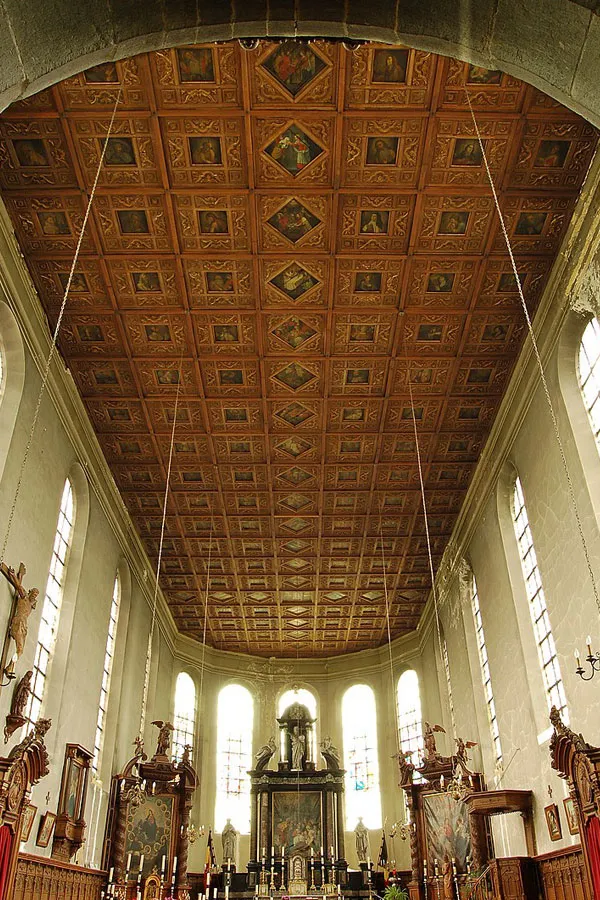
Description of the Primitive State
Sanctuary of Our Lady of Foy, Dinant – The plan of the building is of the “chapel” type. The volume is unique from the arcades. The spaces between these are condemned by walls which thus form a sort of narthex between the portal and the nave. The primitive aspect of this “narthex” is hypothetical. It is either open or closed in relation to the central body of the chapel. The latter is composed of a nave and a five-sided choir.
The building is oriented along the northwest to southeast axis. The dimensions of the Chapel are singular: almost 40 meters long and 11.5 meters wide. The access points inside the chapel of the time are probably two in number: a portal on the side of the north-west facade and a door on the side of the north-east facade. An interior staircase is present in the northwest corner near the portal.
Exterior

Sanctuary of Our Lady of Foy, Dinant – The exterior elevation is made up of two distinct elements: the main facade and the other facades which, apart from small exceptions, have very similar characteristics. The junction between each facade is made of stone. It is a besace angle chain whose stones have variable dimensions and whose organization is not homogeneous. A projecting basement (with two levels in stone) reigns all around the building except in two places where it is interrupted by the two accesses to the interior of the chapel.
The upper part of this basement, the entablature level, is essentially made of brick. Two bedding strips restore height for the entire building. A first which was probably to restore the height above the portal to almost a quarter of the level of the entablature and the height before the construction of the bays. The second was to restore the height before the basket-handle arch of all the windows of the building and is located at three quarters of the level of the entablature. The pierced berries in this one have certain characteristics in common. These are windows with basket-handle arches on chained uprights.
The facade has three levels of elevation: the fitted base, the level of the brick entablature which is punctuated by two bands of foundation stones (mentioned above). Finally, the latter is delimited from the previous part by another band of foundation stone, the gable with two sides.
This side of the building is pierced by a portal of which we do not know the primitive aspect (probably of realization similar to the work of the bays), two bays shorter than today, an oculus in the gable surrounded by two small square-shaped bays. The uncovered gable has in its upper part seven anchors of various sizes and shapes (straight or volute) and, at its base, four anchors dating the building, “1623”.
The two side walls (nearly 14 meters high) both have the same characteristics, except for the door (northwest side) mentioned above. They have two levels: the basement and the brick entablature punctuated by two bands of bedding stone. The first two windows from the main facade are lower in height than the other four. The shorter windows were probably to be the same height as those on the main facade, i.e. four meters in height. The other bays are about eight meters high. Less than one meter from each first window of these side facades and also less than one meter in height, one, above each strip of seating,
The five sides of the choir are similar. Each of them is more or less three meters wide. A window similar to the higher windows of the side facades, is centered in each pan.
The covering of the chapel (roof) as well as of the campanile are ensured by a saddleback roof composed of straight slates. This one has an upturned sewer supported by a stone cornice in cavet on corbel in heel.
Interior

The interior elevation has a different number of levels for each part of the building. However, one level is common to the whole building: the attic. These are delimited by the upper part of the coffered ceiling which is in fact a suspended ceiling between the trusses making up the roof structure which supports the roof.
After the “narthex” part, the aspect of which is unknown, come the nave and the choir. Both are covered by a coffered ceiling whose beams are sculpted. The floor of the entire chapel is covered with a marble pavement (probably in Rance marble). At the time, it is very likely that it was only made of this type of marble. The black marble appears to be an addition made in later work.
The nave has a single level of elevation for the south-east and north-west side walls: a large wall pierced at regular intervals by the windows. The walls are probably covered with a coating (no information is available on the color of the walls). The side walls are covered (from the ground up to 2.50 meters in height with oak paneling interrupted only to the north-west by the access presented previously and by elements of the furniture.
The choir has a single level of elevation: a wall made up of 5 sections, each of which is pierced by a window. This part of the chapel is higher than the nave and is separated from the latter by a step. The walls were very probably covered with a plaster, itself even covered with paints.
The known ornament of the chapel for this period is the band that goes around the nave and the choir which probably served as a frieze, the commemorative plaques (which are added to the walls during particular events, such as an important visit or the death of a character strongly linked to the history of the chapel such as the hermit), the elements of the “furniture” (such as statues placed on pedestals attached to the wall) as well as the paintings and the work of the framing of these composing the coffered ceiling.
Style
The styles attributed to the chapel are numerous. They are often given to the chapel by an observation of particular elements of it and not on the basis of an observation of the whole. The chapel of Notre-Dame de Foy is unique in its kind and breaks with the usual conception of a religious building of this magnitude, that is to say the church with three naves. It also breaks with the conception of the axis as much Romanesque as Gothic by adopting a horizontal axis.
When drawing up this “Manifesto of the Tridentine Church”, different architectural concepts were used. They result from the counter-reform spirit brought by the Council of Trent (1545-1563) through the Jesuits and “Instructions” left by Saint Charles Borromeo (died 1584). However, despite the adoption of a particular “style”, the factory still betrays its regional nature.
Given the region in which it is located, it is normal to want to link the chapel of Notre-Dame de Foy to local and traditional traditions and styles. This is therefore sometimes referred to as the Mosan style of the 16th century due to its exterior sobriety.
The style most often attributed to this building is the “baroque” style. This style requires, according to Ch. Pacco, large windows with transparent glazing (this conception of glazing is opposed to that of the Middle Ages) to highlight its typical decor (highlighting white light). Baroque art, still according to this author, is also characterized by its link with faith, the effects of movement, dynamism, splendor and luxury. But in our regions, it is above all the concretization of new ideas and is strongly linked to the liturgy. However, according to him, this style applies only to the furniture and the chancel.
Another style is also attributed to the chapel: the Renaissance style. According to Pacco Ch., it is the decorative envelope that should be qualified as such. While in the Annals of the archaeological society of Namur, this building is of “humanist tradition of the Renaissance”.
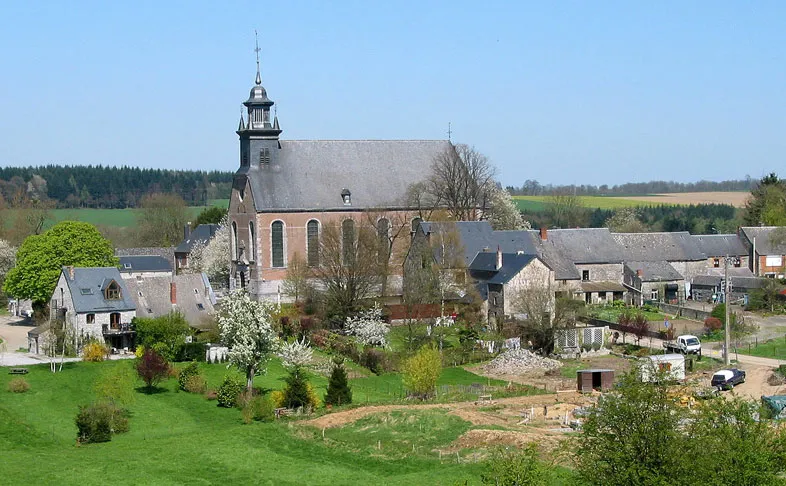
Reverence Abroad
In Quebec: The Jesuit missionary Pierre Chaumonot, when he built (1669) a chapel for the Hurons whom he evangelized in New France (Quebec), dedicated it to Notre-Dame de Foy: the statuette sent to him by Father de Véroncourt is honored there. A whole town developed and became the town of Sainte-Foy 6. The statuette can be seen at the First Nations Museum in Wendake.
In Auriesville (United States): venerated since 1675 by the Mohawks. Today the cult lives again under the name of Our Lady of the Martyrs.
In the reductions of Paraguay : Devotion was introduced there in 1640 by Fathers Pierre de la Marcq and Nicolas du Toict, missionaries from the southern Netherlands who took with them a representation of Our Lady of Foy. The Reduction is baptized Santa Maria de Fe. After the departure of the Jesuits it was transformed into a city: Santa-Maria de Fe.
In the village of the Vosges near Vittel, Girovillers-sous-Montfort (Domjulien), a chapel where there is a reliquary is also celebrated every year on July 2nd, Feast of the Visitation, the Virgin of Our Lady of Foy.
Religious and Artistic Heritage
- The church, in Mosan Baroque style, is modest in appearance: a simple rectangular building. A nave without aisles is extended by a choir from which it is barely distinct (without transept). Many large bay windows, without stained glass, provide plenty of light.
- The ceiling is remarkable. It is flat and made up of 21 rows of 7 boxes (5 boxes on the last row, at the back of the choir). Each oak box includes a painting representing the evangelists, doctors of the Church and various saints and blessed of the Church. The transverse central row forms with the fourth row a Latin cross: the painting frames, in diamond shape, are wider there, underlining the importance given to the mysteries of the life of the Virgin Mary and to the Marian dogmas which are represented there.
- The main altar is surmounted by a painting representing the birth of Jesus, the work of the Liège painter François Walschartz (1597-1678), a disciple of Rubens.
- The Notre-Dame de Foy statuette – barely 22 centimeters – is on the predella of the left altar. To the left of this altar is the painting offered by the Archdukes Albert and Isabella in 1619: a Virgin and Child, with John the Baptist and his mother Saint Elizabeth.
Feast Day - 27th July
Annual Feast Day of Our Lady of Foy (Our Lady of Faith) held on 27th July.
Church Visiting Time
Every Days : 9:00 am to 6:00 pm
Contact Info
Rue des Claviats 4, 5504,
Foy-Notre-Dame, Dinant, Belgium.
Phone No.
Tel : +32 82 68 84 87
Accommodations
How to reach the Sanctuary
The nearest airport to the Sanctuary is Charleroi (CRL) Airport, and other nearby airports include Brussels (BRU), Luxembourg (LUX), Eindhoven (EIN) and Cologne Bonn (CGN).
Dinant Railway Station in the Belgian city of Dinant is the nearby Train Station to the Sanctuary.


